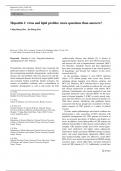Hepatol Int (2011) 5:865–867
DOI 10.1007/s12072-011-9298-3
EDITORIAL
Hepatitis C virus and lipid profiles: more questions than answers?
Ching-Sheng Hsu • Jia-Horng Kao
Received: 19 May 2011 / Accepted: 30 June 2011 / Published online: 29 July 2011
Ó Asian Pacific Association for the Study of the Liver 2011
Keywords Hepatitis C virus � Pegylated interferon � cardiovascular diseases and diabetes [2], is known to
Apolipoprotein C-III � Fibrosis aggravate hepatic steatosis, drive liver fibrosis progression,
and increase the risk of hepatocellular carcinoma (HCC)
[4]. Therefore, metabolic factors and their adjustments
Overnutrition and sedentary lifestyle have increased the have been increasingly recognized in the clinical practice
global prevalence of diabetes and obesity [1]. In addition, of hepatology, and become hot subjects in this active
the accompanying metabolic derangements, cardiovascular research field [5].
diseases [2], non-alcoholic fatty liver disease [3], and dif- In the meantime, hepatitis C virus (HCV) infection
ferent malignant diseases also heavily impact public health affects [170 million people with severe liver disease,
and economic burden worldwide. Insulin resistance, the including chronic hepatitis, liver fibrosis, cirrhosis, and
essence of metabolic syndrome with a constellation of HCC [6]. Therefore, HCV infection bears a huge disease
metabolic derangements as well as risk factors for both burden globally, and it is prudent to eradicate the virus and
halt disease progression in patients with chronic HCV
C.-S. Hsu infection. Unfortunately, the current standard of care with
Division of Gastroenterology, Department of Internal Medicine, pegylated interferon-a plus ribavirin (RBV) for the treat-
Buddhist Tzu Chi General Hospital, Taipei, Taiwan ment of chronic hepatitis C (CHC) is costly, poorly toler-
ated, and only effective in a certain portion of patients [7].
C.-S. Hsu
School of Medicine, Tzu Chi University, Hualien, Taiwan With these reasons, identifying and modifying factors
associated with disease progression or predictive of thera-
J.-H. Kao (&) peutic response in CHC patients is a matter of clinical
Graduate Institute of Clinical Medicine, National Taiwan
concern.
University College of Medicine and National Taiwan University
Hospital, 7 Chung-Shan South Road, Taipei 10002, Taiwan Of note, ample epidemiologic and clinical evidence has
e-mail: kaojh@ntu.edu.tw demonstrated a close association of HCV infection with
metabolic derangements [8]. CHC patients are known to
J.-H. Kao
have an increased prevalence of diabetes and hepatic ste-
Department of Internal Medicine, National Taiwan University
College of Medicine and National Taiwan University Hospital, atosis. In addition, serum lipid profiles of CHC patients are
Taipei, Taiwan different from healthy or other disease control subjects. For
example, CHC patients usually have lower serum triglyc-
J.-H. Kao
eride, total cholesterol, but higher serum adiponectin,
Department of Medical Research, National Taiwan University
College of Medicine and National Taiwan University Hospital, homeostasis model assessment (HOMA)-insulin resistance
Taipei, Taiwan index, and serum high-density lipoprotein (HDL) levels
than matched healthy adults [9]. Moreover, serum HCV
J.-H. Kao
RNA levels were positively proportional to HOMA-insulin
Hepatitis Research Center, National Taiwan University College
of Medicine and National Taiwan University Hospital, resistance index, serum triglyceride, and total cholesterol
Taipei, Taiwan levels in CHC patients [10, 11]. Additionally, several lines
123




